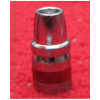I was looking at Hodgdon's website at H110 loads - and just playing with muzzle nrg with the various loads they showed for max loads. I noticed the lighter bullets and loads seemed to generate more muzzle nrg for the same pressure.
Am I noticing kind of a sweet spot for nrg around 125 grains for .357 out of a rifle, their test barrel was 18.5 inches. Am I looking at this wrong? Does the same thing happen with pistol loads? Is this why 9mm is common in 124 grain bullets? Is the original 158 grain load, really not the best for the cartrdige in terms of what you can get in performance out the available pressure limits?
Grains - Muzzle nrg
110 - 1404
125 - 1438
140 - 1240
150 - 1087
158 - 1083
Am I noticing kind of a sweet spot for nrg around 125 grains for .357 out of a rifle, their test barrel was 18.5 inches. Am I looking at this wrong? Does the same thing happen with pistol loads? Is this why 9mm is common in 124 grain bullets? Is the original 158 grain load, really not the best for the cartrdige in terms of what you can get in performance out the available pressure limits?
Grains - Muzzle nrg
110 - 1404
125 - 1438
140 - 1240
150 - 1087
158 - 1083





